MARKETING
How SMEs Can Improve Marketing Efficiency within Budget

Marketing is a vital element of any SME’s operation—especially if you’re just starting out.
Marketing is a way to get your name out there, reel in new customers, convert browsers to buyers, and build a core of loyal customers who will sustain your business through thick and thin.
All in all, marketing is worth doing—and it’s worth doing well. But of course, marketing comes with its fair share of challenges, not least the fact that it can be expensive.
Many SME owners are willing to grit their teeth and pay top dollar for great marketing. After all,, marketing campaigns can have fantastic ROI in terms of profit generated. That said, if you’re concerned about cash flow, it’s worth trying to make your marketing as cost-effective as possible.
With the right marketing strategies and the best software to back you up, it’s possible to make your campaigns more efficient without spending too much. You can generate significant campaign results for relatively little outlay through clever, targeted tactics and consistent engagement with your user base.
How? Let’s take a look.
Partner with Influencers & Brand Ambassadors

In terms of marketing efficiency, influencer marketing has a massive advantage over branded posts. Why? Influencers have incredible reach and committed followers who trust their recommendations.
The best influencers are also adept at digital storytelling, enabling them to create compelling, engaging content that resonates with audiences.
That said, it’s essential that you approach the right influencer to be your brand ambassador. Pick someone likely to appeal to your target customers.
To do this, dig into your customer metrics and establish what (and who) your customers will likely find engaging, informative, or simply entertaining. Go through your marketing data, CRM, and customer service records to better understand who your customers are and what they want.
It’s also worth investing in an ERP system, as this can connect all your data repositories, making it significantly easier to collect, collate, and understand your customer’s activity in a meaningful way. You can then use what you’ve learned to pinpoint the perfect influencer for your brand and which products they should focus on.
Encourage Training & Upskilling
Your staff is your best resource—and a more efficient marketing team means more efficient marketing.
Training and upskilling may seem expensive, but it’s worth the investment. A talented, well-trained marketing team can exponentially boost your marketing ROI.
Conducting training shouldn’t be a one-off, either. Marketing is constantly evolving. So marketers need to have their fingers firmly pressed on the pulse of industry trends and events.
Regular retraining and upskilling will keep your marketers up-to-date with current marketing trends. This, in turn, will enable them to work at the cutting edge of their industry.
Focus on SEO
SEO is a highly efficient, cost-effective way to boost your business’s online presence. You can get to the top of Google’s search rankings with relative ease by using an effective SEO strategy.

It’s a simple equation: as Google is often the first place people turn to when looking for a product or service, the more Googlable your business is, the more leads you will bring in.
To boost your SEO, you need to think about the following:
- Producing high-quality content
- Engaging with online audiences
- Having a solid, reputable online presence
- Keeping your social media updated
- Using keywords in your online content
- Staying on top of algorithm changes and SEO trends
Partner with Complementary Businesses
Building a network is a fantastic way to establish your brand without chewing into your marketing budget.
If you can find a business that complements your own, partnering with them for content campaigns and other messages could be a win-win situation.
For example, let’s say you’re in the business of selling cookware. A company that produces or sells cooking ingredients could be a fantastic partner. Together, you could produce recipe blog posts, video tutorials, and culinary tips featuring your cookware and their ingredients, all for relatively little cost.
You can then post this content across your brand’s platforms and theirs, doubling your reach in a single stroke.
Again, businesses you partner with must be relevant to your own. For example, if your cookware company partners with an art supplies store, customers will struggle to see the connection between the two. After all, art enthusiasts aren’t heading to a creative blog for cooking tips, nor will your customers expect to find painting tutorials on your social media channels!
With that in mind, look for businesses with a customer base likely to be interested in your products and vice versa.
Foster User-Generated Content
User-generated content (UGC) can make a big impact.
A good UGC campaign can simultaneously send engagement levels through the roof, boost brand/customer relationships, and vastly increase your reach.
Let’s take a look at a simple, but very successful, example.
In 2022, Shakira released a track with the Black Eyed Peas. Having been out of the mainstream eye for a while and wanting to make a huge comeback, Shakira generated a buzz about this new track by calling on fans old and new.
Her #girllikeme challenge invited TikTokkers to recreate the complex dance from the ‘Girl Like Me’ music video. Unable to resist, TikTok exploded with dance videos. In response, Shakira posted compilations of the best, most inventive, most amusing, and most relatable on her Instagram account.
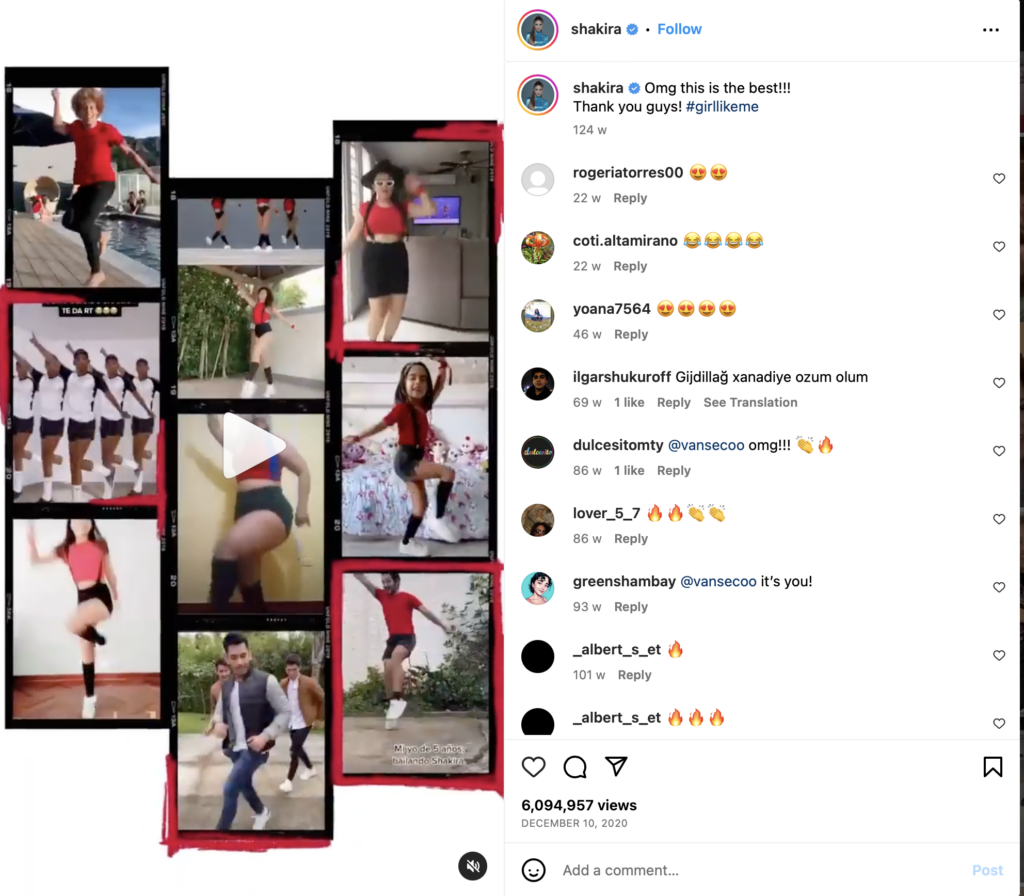
The upshot was that the track gained a huge boost in plays and popularity. In addition, the hashtag had nearly 500 million views, and Shakira was catapulted back into the mainstream media.
You may not be Shakira, but you can still create a memorable, wide-reaching marketing campaign by encouraging UGC challenges, hashtags, and so on.
Think about how you can challenge customers to get creative with your products and share the results, whether it’s fun ways to reuse packaging or funny photos of pets using your product.
Contests are also a great way of incentivizing users to create content. The price of awarding a prize is worth the ROI of a successful UGC campaign.
Repurpose or Update Old Campaigns
You don’t want to churn out the same old ideas. But at the same time, there is little point in changing a winning formula just for the sake of it.
If an ongoing campaign is working well, keep using it. If a particular message or campaign worked well in the past, freshen it up and reuse it.
Even if you can’t recycle them, old campaigns are a great resource. Historic campaign data can offer useful insights about what does and doesn’t resonate with your customers.
If you want to be thorough, you should compare your campaign data with historical customer and sales data. This will give you a more in-depth analysis and help you to pinpoint why specific campaigns were successful.
To do this, make use of tools like cloud ERP software. This will give you access to the data you need, but also, as it’s a cloud-based solution, it will allow anyone on the team to access data from anywhere.
In this way, the marketing team can easily cross-reference campaign data with metrics like customer satisfaction, conversion rate, and complaints. It’s also beneficial for collaborating with other departments in real-time, so you can access historical data to make better decisions, even if you’re on the go.
But, it is important to be proactive about this. Simply churning out the same old campaigns because they worked once isn’t going to cut it.
Customer tastes change quickly. So, even if you feel that a campaign is still as relevant and engaging as before, it’s still essential that you update it for today’s market.
Utilize Referral Marketing
This is often confused with word-of-mouth marketing and UGC marketing. While there is some overlap between the three, referral marketing is different enough to deserve its own category.
Referral marketing directly incentivizes the customer to bring in new customers. In a typical example, a brand will offer customers a reward—often cashback, a gift card, discount, or free gift—if they persuade a friend to sign up for your service.
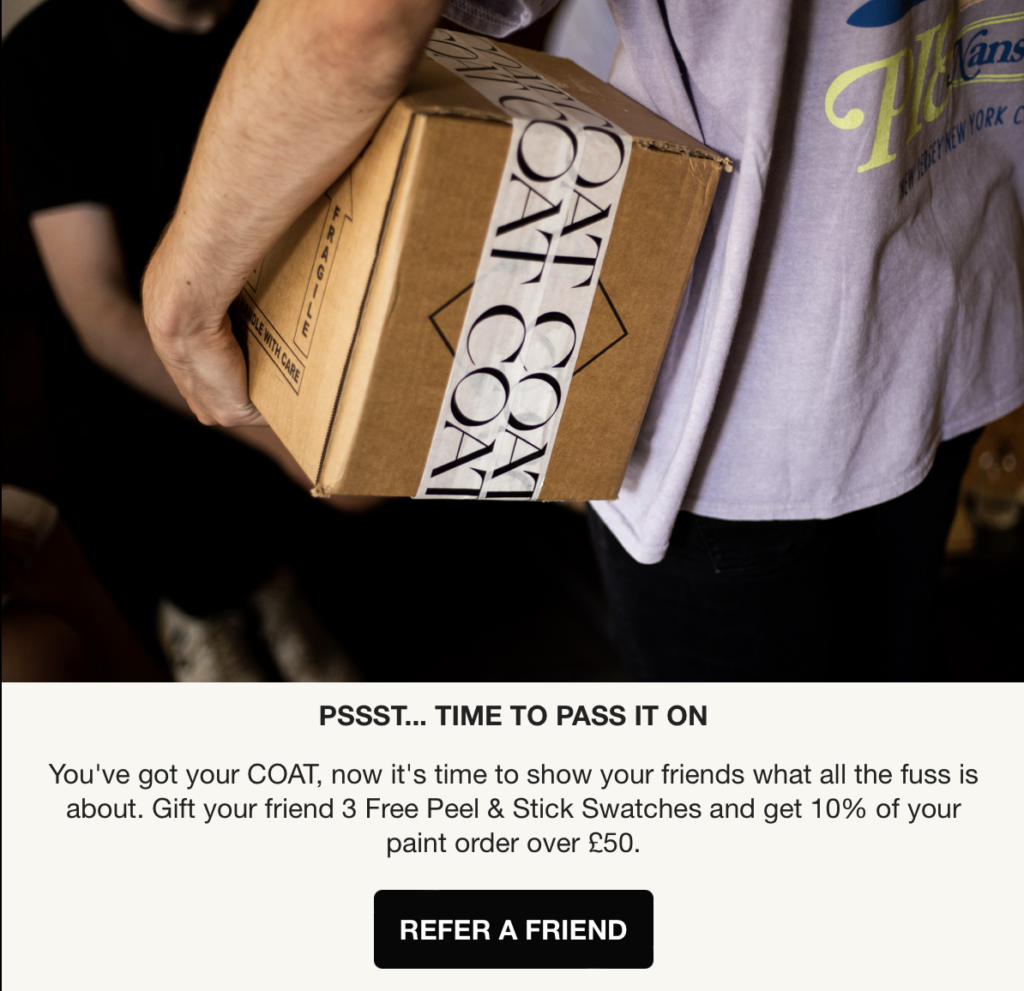
It’s worth noting that referral marketing is more common for businesses offering services rather than selling products. These businesses need customers to actively sign up for an ongoing brand/customer relationship rather than simply purchasing a new product whenever needed. However, it can work for product vendors as well.
To make sure customers are properly rewarded for referrals, set up a referral link system. When someone signs up using a customer’s referral link, your ERP software or other system will automatically note the details so everyone gets their referral bonus.
Efficient marketing campaigns don’t have to be expensive. Through careful planning, clear customer insights, an effective ERP system, and clever strategizing, you can run great campaigns with brilliant ROI, for very little initial outlay.
Digital channels offer huge opportunities to leverage your network and engage your customer base in brand-building ways without breaking the bank.
Sure, you get what you pay for in terms of staff, graphics, and so on. But marketing efficiency is more about knowing where and when to deploy that money. It’s about being strategic and insightful, rather than hoping that money will talk.
With the right approach, you can achieve a high degree of marketing efficiency and fantastic ROI—and you don’t have to increase marketing spend to do it.
MARKETING
3 Contextual Link-Building Strategies That Actually Work

Quality content can get your web pages ranking higher in Google search results. But contextual links can help, too.
Google says the inclusion of relevant, high-quality links signals the content that includes them may be quality content, too.
So, how can you earn contextual links to give your content an edge over the competition? Adopt one, two, or all three of the strategies detailed in this article.
But first, let’s understand what contextual links are.
What are contextual links?
A contextual link appears in the body of a web page’s content. A hyperlink is added to a relevant word or phrase. They:
- Link to other pages on the site.
- Cite the source of a claim or statistic.
- Indicate other relevant pages.
- Provide readers with more in-depth information on the topic.
- Guide readers to a product or service.
In this screenshot of an article with the header, Challenges of Productivity Tracking in Remote Workplaces, three phrases are hyperlinked — measure productivity, Microsoft, and research by Gartner.
Each contextual link serves a purpose:
- “Measure productivity” goes to a Slack article about how to measure employee productivity.
- “Microsoft” directs the reader to the original research for the cited statistic.
- “Research by Gartner” links to the native source for the research cited in that paragraph.
With a contextual link-building strategy, you not only boost your content in the eyes of Google but also encourage other sites to use your valuable content to provide their readers with additional information or context.
Now, let me show you three strategies to grow your contextual links and improve your content’s rankings.
1. Help sites fix their broken links
Broken link building involves contacting a website, pointing out a broken external link on a page, and suggesting your content as its replacement.
Broken links could result from a 404 error, a blank page, or a redirect to an irrelevant page — any alteration that ruins the original link’s purpose.
Since broken links negatively affect the visitor experience, removing them is in the site’s best interest. Your replacement offer gives them a quick solution to their problem. Plus, people are more willing to help you after you’ve helped them.
To find broken links, use a tool like Free Backlink Checker extension. I also like to inspect links manually since most tools only pick up 404 errors. Rely solely on them, and you will miss relevant broken-link opportunities.
Ahrefs also has tools for finding broken links. Its free broken link checker is helpful, but the paid version is more robust.
Paid subscribers can go to Site Explorer, go to the Outgoing Links report, and click on “Broken Links” from the dropdown menu.
The report identifies the total number of broken links (3,136 in the example below), the referring pages (the URL for the content including the broken link), the anchor (the words hyperlinked in the content), and the link (the URL that no longer directs to a viable page).
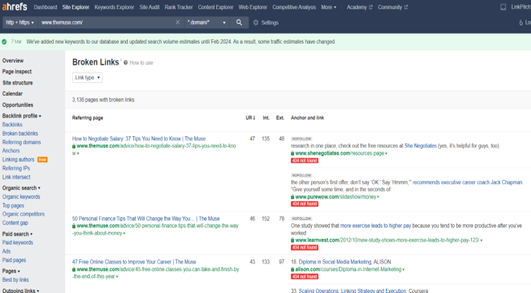
Ahrefs subscribers can also compile a Best by Links report under the Pages option in the Site Explorer tool.
In this example, the report lists pages with 404 page-not-found errors for TheMuse.com. It has 6,230 pages with broken external links. Each page URL listed is accompanied by the number of referring domains and a number of links to the page.
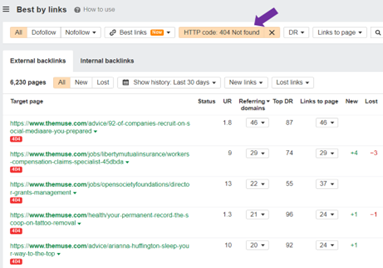
This research can identify the topics with the biggest potential to become the fixes for a broken link. You can create content to address them or identify content you already published. Just make sure the content closely matches the intent of the anchor text’s original link.
For example, the same research report, which is now a broken link, is cited in articles from Oyster and TINYpulse. On Oyster, the anchor text reads, “44% of companies did not allow remote work.” On TINYpulse, the anchor text says, “only 33% are very satisfied with the level of trust in their organization.”
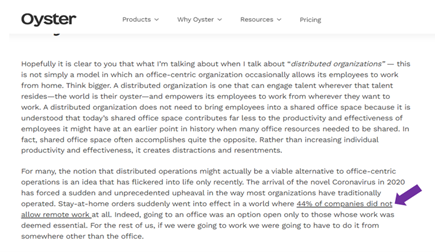
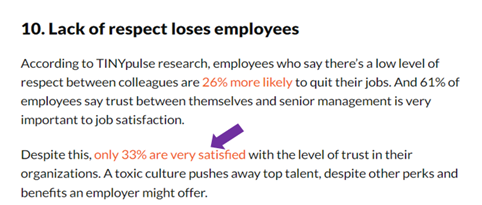
For a single article link to replace the broken link on Oyster and TINYpulse, the content would need to cite both a statistic about remote work and another stat about trust in organizations.
2. Guest posting
Like the broken-link replacement strategy, guest posting benefits both your and the recipient’s sites. You reach out to sites and offer to write content about a topic relevant to their audience that relates to your content subjects and includes a link to your site. This technique works well because you typically control where and how to add your link to make it as relevant as possible.
You can take multiple approaches to win guest-posting opportunities. No matter which tactics you use, track the sites and verify the site’s quality using Ahrefs, another tool, or a direct visit to the site.
First, you can use Ahrefs (or a similar tool) to examine your competitors’ backlinks and identify any links that come from guest posts. The anchor or surrounding text might hint at its status with phrases such as “contributed by,” “guest post by,” or the name of the brand or author. You also can check links manually to see if they’re contributed content.
In this example from Collegiate Parent, the headline reads “EFC Too High? Tips for Successful Aid Appeals” and includes a byline for “Billie Jo Weis.” At this point, you don’t know if it is a contributed article.

But scroll down to the end, and you can see the author’s bio. It confirms the article is a guest post because her bio says she is a client services advisor for My College Planning Team, not the publisher (Collegiate Parent).

You can also use Google search operators to identify sites open to guest contributions. You’ll want to do several searches using variations of your target keywords and topic accompanied by phrases, such as “guest post,” “contributed by,” “guest post by,” and “guest posting guidelines.”
The example in the screenshot below works for a brand targeting college prep topics. The search is “’college prep’ ‘guest post by’ -site.pinterest.com.” The results reveal four articles from four sites that use the words “college prep” and “guest post by.” You can add those sites to your outreach tracker.

Finally, you can list sites relevant to your niche that didn’t appear in the earlier searches.
TIP: Not all sites that accept guest articles say so on their website.
3. Niche edits
A niche edit, sometimes referred to as a link insert, is a technique that adds a link to existing content. The key to success is finding relevant articles on high-quality sites and pitching your content as a valuable addition to those articles.
You can use a similar process to the Google guest post search. Input a broad keyword for your targeted keyword, then tell it you don’t want the targeted keyword in the title. If the entire article is about your targeted keyword, your chances of getting the publisher to include a link to a similar article are low.
Here’s an example from one of our client’s that sought to make niche edits for the keyword “soft skills.”
The Google search included these phrases:
- “Organizational development” soft skills -intitle:”soft skills”
- “Organizational development” soft skills employee training -intitle:”soft skills”
- Soft skills employee training -intitle:”soft skills” organizations
It led to an added link for “soft skills” in this article — “Employee Development,” which includes the header, “What are the benefits of employee development for an organization?”
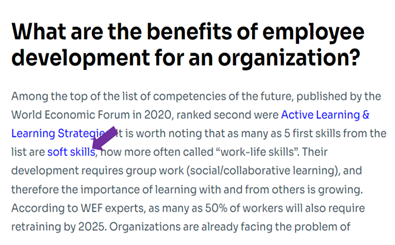
You can do several searches, modifying your search operators each time to see what sites and content appears. Think of multiple angles to broaden the potential sites that publish content with your targeted or a related keyword.
After you’ve crafted a list of high-quality prospects, it’s time for outreach.
Niche edits might be the hardest of the three strategies to achieve because they’re not as clear of a win-win situation as the other two (repairing broken links and publishing new content).
Your email pitch can make or break your niche-edit campaign. It must convince the publisher that your content provides so much value that they will want to take an extra step with content they’ve already completed.
Here are some tips to craft a link-earning email pitch:
- Start by mentioning something about them. It could be something you like about their website or the article you’re targeting. You want them to know you’ve explored their site and read the article. But don’t overdo it. A simple compliment or sentence about how you found the article helpful should suffice.
- Introduce your content and mention how it can help their audience. Be concise and convincing, but don’t oversell it.
- Go one step further and point to a section or sentence where you think your content might be a good fit. This will help them see where your content can add value and link to it.
Get linking
Though contextual link building may seem challenging to execute, it can bring great rewards. Follow these tips and strategies, and your valuable content will get more attention from external sites and eventually Google rankings where it deserves to be.
All tools mentioned in this article are identified by the author. If you have a tool to suggest, please tag CMI on social.
HANDPICKED RELATED CONTENT:
Cover image by Joseph Kalinowski/Content Marketing Institute
MARKETING
Google’s Surgical Strike on Reputation Abuse
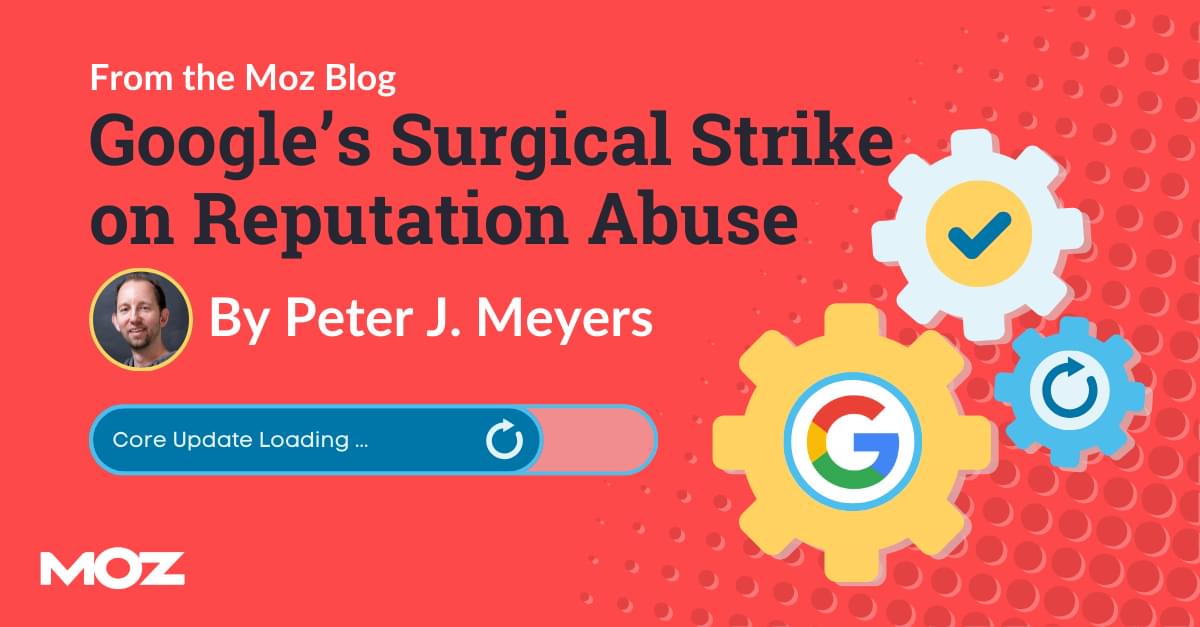
These aren’t easy questions. On the one hand, many of these sites do clearly fit Google’s warning and were using their authority and reputation to rank content that is low-relevance to the main site and its visitors. With any punitive action, though, the problem is that the sites ranking below the penalized sites may not be of any higher quality. Is USA Today’s coupon section less useful than the dedicated coupon sites that will take its place from the perspective of searchers? Probably not, especially since the data comes from similar sources.
There is a legitimate question of trust here — searchers are more likely to trust this content if it’s attached to a major brand. If a site is hosting third-party content, such as a coupon marketplace, then they’re essentially lending their brand and credibility to content that they haven’t vetted. This could be seen as an abuse of trust.
In Google’s eyes, I suspect the problem is that this tactic has just spread too far, and they couldn’t continue to ignore it. Unfortunately for the sites that were hit, the penalties were severe and wiped out impacted content. Regardless of how we feel about the outcome, this was not an empty threat, and SEOs need to take Google’s new guidelines seriously.
MARKETING
18 Events and Conferences for Black Entrepreneurs in 2024

Welcome to Breaking the Blueprint — a blog series that dives into the unique business challenges and opportunities of underrepresented business owners and entrepreneurs. Learn how they’ve grown or scaled their businesses, explored entrepreneurial ventures within their companies, or created side hustles, and how their stories can inspire and inform your own success.
It can feel isolating if you’re the only one in the room who looks like you.
-

 SEO7 days ago
SEO7 days agoHow to Use Keywords for SEO: The Complete Beginner’s Guide
-

 MARKETING5 days ago
MARKETING5 days agoAdvertising on Hulu: Ad Formats, Examples & Tips
-

 MARKETING2 days ago
MARKETING2 days ago18 Events and Conferences for Black Entrepreneurs in 2024
-
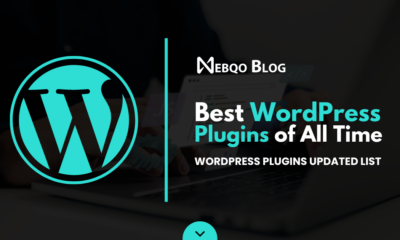
 WORDPRESS5 days ago
WORDPRESS5 days agoBest WordPress Plugins of All Time: Updated List for 2024
-

 MARKETING6 days ago
MARKETING6 days agoUpdates to data build service for better developer experiences
-

 WORDPRESS6 days ago
WORDPRESS6 days agoShopify Could Be Undervalued Based On A Long-Term Horizon
-

 MARKETING7 days ago
MARKETING7 days agoThe Ultimate Guide to Email Marketing
-

 PPC6 days ago
PPC6 days agoLow Risk, High Reward YouTube Ads alexking
















